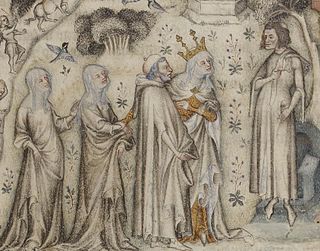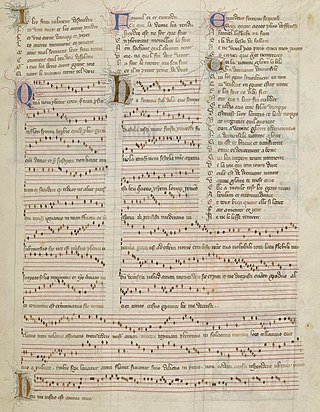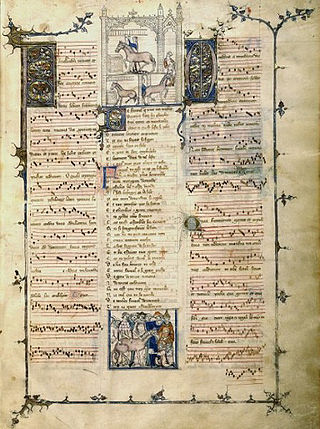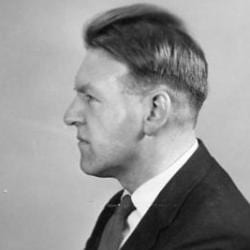Related Research Articles

Medieval music encompasses the sacred and secular music of Western Europe during the Middle Ages, from approximately the 6th to 15th centuries. It is the first and longest major era of Western classical music and followed by the Renaissance music; the two eras comprise what musicologists generally term as early music, preceding the common practice period. Following the traditional division of the Middle Ages, medieval music can be divided into Early (500–1150), High (1000–1300), and Late (1300–1400) medieval music.

Guillaume de Machaut was a French composer and poet who was the central figure of the ars nova style in late medieval music. His dominance of the genre is such that modern musicologists use his death to separate the ars nova from the subsequent ars subtilior movement. Regarded as the most significant French composer and poet of the 14th century, he is often seen as the century's leading European composer.

Isorhythm is a musical technique using a repeating rhythmic pattern, called a talea, in at least one voice part throughout a composition. Taleae are typically applied to one or more melodic patterns of pitches or colores, which may be of the same or a different length from the talea.

Philippe de Vitry was a French composer-poet, bishop and music theorist in the ars nova style of late medieval music. An accomplished, innovative, and influential composer, he was widely acknowledged as a leading musician of his day, with Petrarch writing a glowing tribute, calling him: "... the keenest and most ardent seeker of truth, so great a philosopher of our age." The important music treatise Ars nova notandi (1322) is usually attributed to Vitry.

Ars nova refers to a musical style which flourished in the Kingdom of France and its surroundings during the Late Middle Ages. More particularly, it refers to the period between the preparation of the Roman de Fauvel (1310s) and the death of composer Guillaume de Machaut in 1377. The term is sometimes used more generally to refer to all European polyphonic music of the fourteenth century. For instance, the term "Italian ars nova" is sometimes used to denote the music of Francesco Landini and his compatriots, although Trecento music is the more common term for the contemporary 14th-century music in Italy. The "ars" in "ars nova" can be read as "technique", or "style". The term was first used in two musical treatises, titled Ars novae musicae by Johannes de Muris, and a collection of writings attributed to Philippe de Vitry often simply called "Ars nova" today. Musicologist Johannes Wolf first applied to the term as description of an entire era in 1904.

F. Andrieu was a French composer in the ars nova style of late medieval music. Nothing is known for certain about him except that he wrote Armes, amours/O flour des flours, a double ballade déploration, for the death of Guillaume de Machaut in 1377. The work has been widely praised and analyzed; it is notable for being one of two extant medieval double ballades for four voices, the only known contemporary musical setting of Eustache Deschamps and the earliest representative of the longstanding medieval and Renaissance lamentation tradition between composers. He may be the same person as Magister Franciscus, although the scholarly consensus on this identification is unclear. With P. des Molins, Jehan Vaillant and Grimace, Andrieu was one of the "post-Machaut" generation whose pieces retain enough ars nova qualities to be differentiated from composers of ars subtilior.
Solage, possibly Jean So(u)lage, was a French composer, and probably also a poet. He composed the most pieces in the Chantilly Codex, the principal source of music of the ars subtilior, the manneristic compositional school centered on Avignon at the end of the century.
Johannes Cesaris was a French composer of the late Medieval era and early Renaissance. He was one of the composers of the transitional style between the two epochs, and was active at the Burgundian court in the early 15th century.
France has a rich music history that was already prominent in Europe as far back as the 10th century. French music originated as a unified style in medieval times, focusing around the Notre-Dame school of composers. This group developed the motet, a specific musical composition. Notable in the high Middle Ages were the troubadours and trouvères soon began touring France, composing and performing many original songs. The styles of ars nova and ars subtilior sprung up in the 14th century, both of which focused on secular songs. As Europe moved into the Renaissance age, the music of France evolved in sophistication. The popularity of French music in the rest of Europe declined slightly, yet the popular chanson and the old motet were further developed during this time. The epicenter of French music moved from Paris to Burgundy, as it followed the Burgundian School of composers. During the Baroque period, music was simplified and restricted due to Calvinist influence. The air de cour then became the primary style of French music, as it was secular and preferred by the royal court.

Messe de Nostre Dame is a polyphonic mass composed before 1365 by French poet and composer Guillaume de Machaut. Widely regarded as one of the masterpieces of medieval music and of all religious music, it is historically notable as the earliest complete setting of the Ordinary of the Mass attributable to a single composer.
The Ivrea Codex is a parchment manuscript containing a significant body of 14th century French polyphonic music.
The Tournai Mass is a polyphonic setting of the mass from 14th-century France. It is preserved in a manuscript from the library of the Tournai Cathedral.

Grimace was a French composer-poet in the ars nova style of late medieval music. Virtually nothing is known about Grimace's life other than speculative information based on the circumstances and content of his five surviving compositions of formes fixes; three ballades, a virelai and rondeau. He is thought to have been a younger contemporary of Guillaume de Machaut and based in southern France. Three of his works were included in the Chantilly Codex, which is an important source of ars subtilior music. However, along with P. des Molins, Jehan Vaillant and F. Andrieu, Grimace was one of the post-Machaut generation whose music shows few distinctly ars subtilior features, leading scholars to recognize Grimace's work as closer to the ars nova style of Machaut. His best known and most often performed work in modern-times is the virelai and proto-battaglia: A l’arme A l’arme.
The 1360s in music involved some significant events.
Robert de Castel (d'Arras) was a trouvère active in and around Arras in the late thirteenth century. He is mentioned in the Congés of Baude Fastoul, written in 1272, which place him Arras at that date. He is the addressee of the poem Robert du Chastel, biaus sire, a jeu parti by another trouvère of Arras, Jehan Bretel, which was judged by another Artesian, Gaidifer d'Avion.
P. des Molins, probably Pierre des Molins, was a French composer-poet in the ars nova style of late medieval music. His two surviving compositions – the ballade De ce que fol pensé and rondeau Amis, tout dous vis – were tremendously popular as they are among the most transmitted pieces of fourteenth-century music. The ballade is found in 12 medieval manuscript sources and featured in a c. 1420 tapestry; the rondeau is found in 8 sources and referenced by the Italian poet Simone de' Prodenzani. Along with Grimace, Jehan Vaillant and F. Andrieu, Molins was one of the post-Guillaume de Machaut generation whose music shows few distinctly ars subtilior features, leading scholars to recognize Molins's work as closer to the ars nova style of Machaut.
The 1340s in music involved some events.
The 1320s in music involved some events.

Gilbert Reaney was an English musicologist who specialized in medieval and Renaissance music, theory and literature. Described as "one of the most prolific and influential musicologists of the past century", Reaney made significant contributions to his fields of expertise, particularly on the life and works of Guillaume de Machaut, as well as medieval music theory.
References
- 1 2 3 4 5 6 Kügle 2009.
- ↑ Leach 2007, p. 211.
- ↑ Desmond 2018, p. 4.
